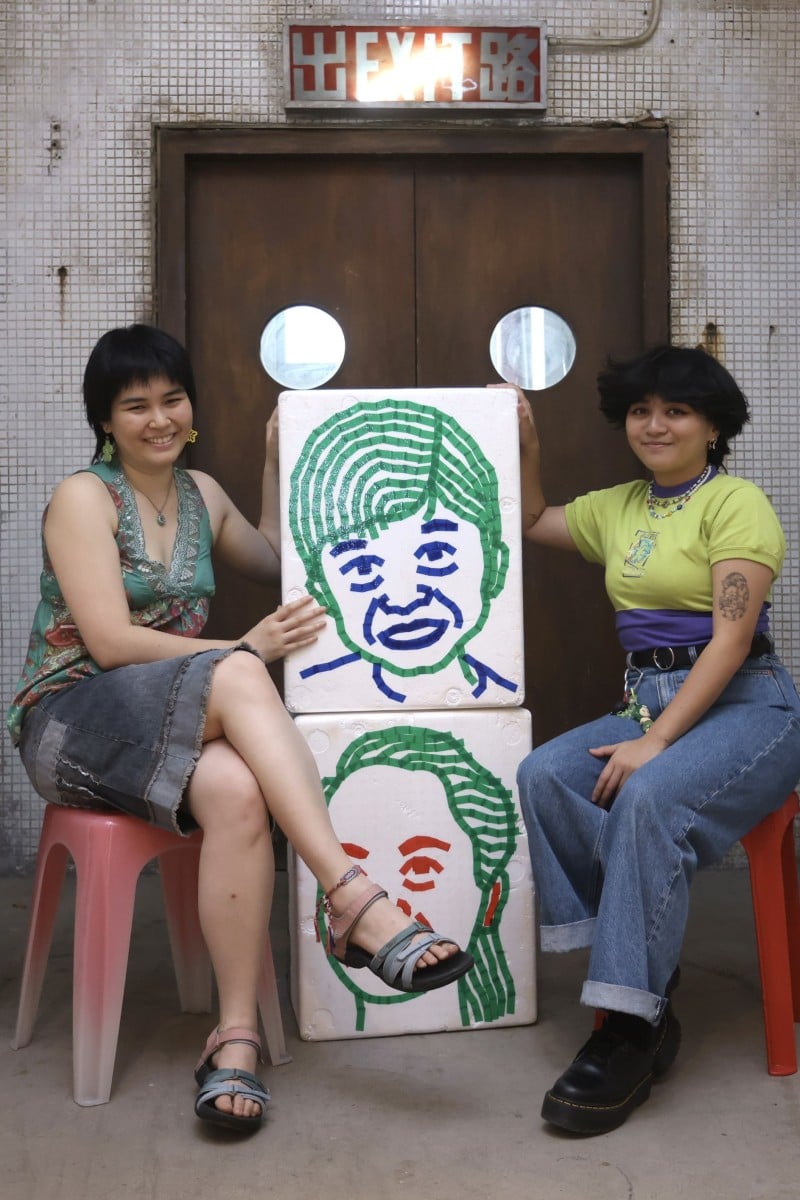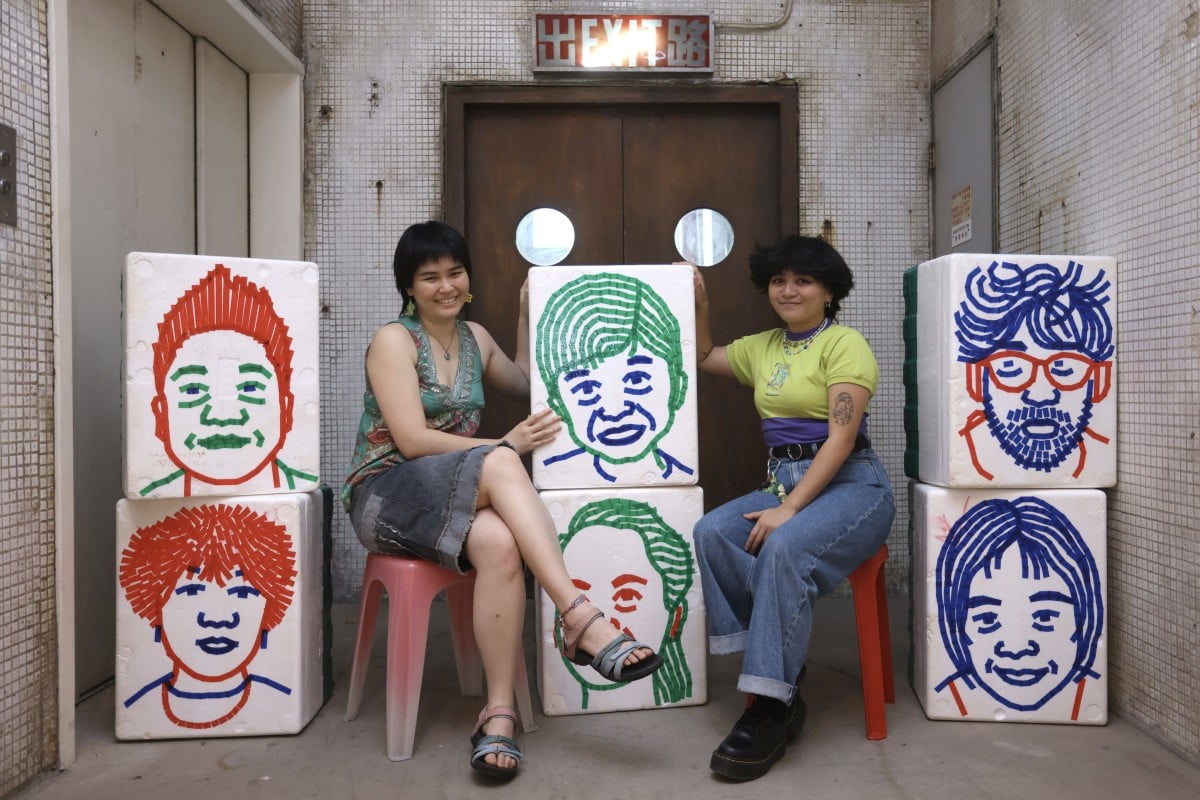
- ‘Marginalia (Notes from the Peripheries)’ in Wong Chuk Hang showcases work from 18 migrant artists and groups and allows them to talk about their experiences and culture
- Every week, Talking Points gives you a worksheet to practise your reading comprehension with exercises about the story we’ve written
 Curator Nicole Nepomuceno and producer Faith Monsod pose with pieces at the Marginalia (Notes from the Peripheries) exhibition at Current Plans gallery in Wong Chuk Hang. Photo: Jonathan Wong
Curator Nicole Nepomuceno and producer Faith Monsod pose with pieces at the Marginalia (Notes from the Peripheries) exhibition at Current Plans gallery in Wong Chuk Hang. Photo: Jonathan WongScattered throughout the “Marginalia (Notes from the Peripheries)” art exhibition are 24 giant mahjong tiles made from discarded styrofoam boxes using red, green, and blue tape to portray the artists featured.
The exhibition, which is being held at Current Plans in Wong Chuk Hang until June 30, features work from 18 migrant artists and groups presenting their pieces in formats ranging from paintings and food to videos.
The mahjong installation was created by the local design studio Pop & Zebra and references the way players discard useless tiles in the Chinese game. It reflects how many in the migrant community end up feeling: “Many ethnic minorities in Hong Kong started from migrant work or labour ... so it comes from that reflection of what our usage is and what our function is in Hong Kong,” said Nicole Nepomuceno, a 25-year-old Filipino curator who moved to the city at age 11.
The exhibition was inspired by Nepomuceno’s research on art history in Hong Kong. She found that ethnic minority artists were often overlooked; the only reference she could find to local exhibits highlighting ethnic minority artists was 1997’s “Being Minorities – Contemporary Asian Art,” curated by Oscar Ho.
“Ho wanted to engage [with] artists of different ethnic origins, but he wrote in an essay that he couldn’t find many at the time,” explained Nepomuceno, who studied art history at the University of Hong Kong.
“It was a foundational starting point for me to think about making a show.”
How one Hong Kong NGO opens doors for ethnic minority youth
Feelings of otherness
Playing with the word “marginalia”, the exhibition addresses the feeling of otherness that migrants experience: “This was a word that I felt could draw parallels between the notes written in the margins and the voices, perspectives, and stories of people from ethnic minority communities in Hong Kong ... because we often occupy this marginal positioning,” said the curator.
But margins can also be freeing and expansive: “You can engage [with] the centre and the other things that are going on in the margins ... Instead of always trying to find ways to have somebody or a group let you in, [you can] see what is around you and where you are.”
Nepomuceno invited her 25-year-old secondary school friend Faith Monsod to produce the exhibition. Born and raised in Hong Kong, Monsod said it was often challenging to find a sense of belonging growing up, saying it was art that helped her embrace herself. The theme of identity crisis is often reflected in both their work.
“There is such freedom [in art], that you are so much more than what people will try to perceive you as and put you in a box because you don’t just exist in a box,” said Monsod, who graduated with a degree in creative media from City University of Hong Kong.
Nepomuceno added that their exhibition aims to explore the marginalised position in a celebratory way: “When I flipped that mirror onto myself and my community, I felt that art could maybe be another way to communicate these kinds of stories ... like this exhibition: it’s multisensory; there’s something that people can feel or can relate to.”
Introducing stories
Marginalia features an array of pieces, including multimedia works with music, a 28-minute documentary, and paintings referencing the migrant experience in Hong Kong and their culture.
One highlight is a cabinet with small wooden items, amulets for protection known as anting-anting in Tagalog, made by Filipino artist Katrina Leigh Mendoza Raimann. Participants are encouraged to take one object from the cabinet to accompany them throughout the exhibition.
The event has received a positive response and appeals to Hongkongers of all backgrounds. In fact, the first visitor to the exhibit was a Cantonese-speaking Hongkonger: “She liked how there was so much to see in the show, and she took her time to walk around,” said Monsod. “She was asking me to explain the different words, as she truly wanted to understand the meaning.”
“At the end of the day, this is a Hong Kong exhibition,” Nepomuceno said. “You don’t have to be [part of] a particular community or a particular person to relate because marginality doesn’t stop at ethnicity.”
“I don’t think art in itself can help change how the city sees its ethnic minorities,” she added. “Art is just something that slowly connects and introduces these stories that already exist.”
To test your understanding of this story, download our printable worksheet or answer the questions in the quiz below.
